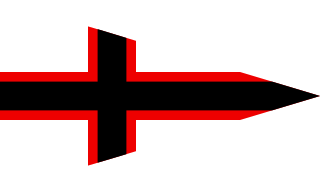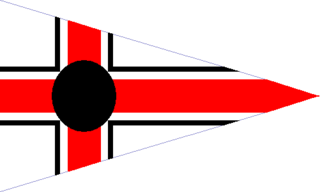History
This club was founded in February 1887 in Kiel by Vice Admiral von Blanc and Navy Engineer Busley along with other 112 officers of the Imperial German Navy. It was established as the "Marine-Regatta-Verein" (Regatta Union of the Navy), an association exclusively for military personnel in order "to foster the joy of sailing". Prince Heinrich of Prussia, a yachting enthusiast, was the patron of the club. The newly-born club organized its first successful regatta already in the same year in June. [1]
In 1891 the 500 naval officers that ran the club elected Emperor Wilhelm II as their commodore. The club's name was altered to "Kaiserlicher Yacht Club" (Imperial Yacht Club). The new statutes allowed civilian members in, so the nature and the purpose of the club changed radically. [2]
In August 1928, most of the active naval officers left the Kaiserlicher Yachtclub and revived the Marine-Regatta-Verein, as an organization attached to the German navy, which became the Kriegsmarine during Nazi times.
The Marine-Regatta-Verein took part in the organization of regattas in the Bay of Kiel, like the Kiel Week and the sailing events of Hitler's 1936 Summer Olympics. As a result the club went through a period of expansion, reaching a record number of 3,600 member, becoming the largest sailing club in Europe.
In 1945, at the end of World War II, the Marine-Regatta-Verein was disbanded by the allied forces in Kiel.
In May 1972 the Marine-Regatta-Verein was refounded in an effort led by Friedrich Rohlfing, who would become its president. The revived club was officially registered under the name Marine-Regatta-Verein im Deutschen Marinebund e.V. (MRV im DMB e.V.). It is under the Verein Deutscher Marinebund (German Navy Association) and it has its seat in Kiel. [3]

The German Navy is the navy of Germany and part of the unified Bundeswehr, the German Armed Forces. The German Navy was originally known as the Bundesmarine from 1956 to 1995, when Deutsche Marine became the unofficial name with respect to the 1990 incorporation of the East German Volksmarine. It is deeply integrated into the NATO alliance. Its primary mission is protection of Germany's territorial waters and maritime infrastructure as well as sea lines of communication. Apart from this, the German Navy participates in peacekeeping operations, and renders humanitarian assistance and disaster relief. They also participate in Anti-Piracy operations.

The Imperial German Navy was the navy created at the time of the formation of the German Empire. It existed between 1871 and 1919, growing out of the small Prussian Navy, which primarily had the mission of coastal defence. Kaiser Wilhelm II greatly expanded the navy, and enlarged its mission. The key leader was Admiral Alfred von Tirpitz, who greatly expanded the size and quality of the navy, while adopting the sea power theories of American strategist Alfred Thayer Mahan. The result was a naval arms race with Britain as the German navy grew to become one of the greatest maritime forces in the world, second only to the Royal Navy. The German surface navy proved ineffective during World War I; its only major engagement, the Battle of Jutland, was indecisive. However, the submarine fleet was greatly expanded and posed a major threat to the British supply system. The Imperial Navy's main ships were turned over to the Allies, but were scuttled at Scapa Flow in 1919 by German crews.

Blohm+Voss (B+V), also written historically as Blohm & Voss, Blohm und Voß etc., is a German shipbuilding and engineering company. Founded in Hamburg in 1877 to specialise in steel-hulled ships, its most famous product is the World War II battleship Bismarck.

Kiel is the capital and most populous city in the northern German state of Schleswig-Holstein, with a population of 249,023 (2016).

A yacht club is a sports club specifically related to yachting.
Nobiskrug is a shipyard located on the Eider River in Rendsburg, Germany, specializing in building luxury yachts and the construction, modification and repair of yachts, naval and commercial vessels. It is now a subsidiary of Privinvest Holding. The shipyard currently employs some 400 people.

The Verein Seglerhaus am Wannsee (VSaW) is the second oldest yacht club in Germany after Segelclub RHE. It is located on the shores of the Greater Wannsee lake, southwest of Berlin.

Kieler Yacht-Club is one of the oldest yacht clubs in Germany. It is located in the harbor city of Kiel.

The Yacht-Club von Deutschland (YCvD), "Yacht Club of Germany", was a yacht club platform established in 1937 during Nazi rule in Germany.

Norddeutscher Regatta Verein (NRV), approx. meaning "North German Regatta Club", is a yacht club in Germany. This club is based in Uhlenhorst, Hamburg, Germany; the clubhouse is located at Hamburg's Lake Außenalster. Founded in 1868,it is one of the oldest and largest yacht clubs in Germany, with some 2,000 members.

Kaiserlicher Yacht-Club, "Imperial Yacht Club", was one of the forerunners of the Kiel Yacht Club. Known also as "Küz" from its acronym KYC, it was a prestigious yacht club located in the harbor city of Kiel, Germany. German Emperor Wilhelm II, his younger brother Prince Heinrich of Prussia and Alfred Krupp were among its members. This club was famous for the sailing events it organized, including its role in the first Kieler Woche regattas, an event that still takes place yearly in the Kiel Bay.

The Württembergischer Yacht-Club (WYC) is a yacht club in Friedrichshafen. It is located on the shores of Lake Constance, Germany. This club was established in January 1911 as the "Königlich Württembergischer Yacht-Club".

The Hamburger Segel-Club (HSC), is one of the oldest and most active sailing clubs in Germany. The club is located by the shores of Lake Außenalster, in the heart of the Free and Hanseatic City of Hamburg.

Sir James Pender, 1st Baronet was a British businessman, yachtsman and Conservative Party politician. He sat in the House of Commons from 1895 to 1900.

August von Thomsen was an Admiral of the German Imperial Navy. He was the son of Adolf Theodor Thomsen and Catharina Tönnies. In 1898 - 1903 he was senior admiral (commander) at the North Sea Naval Station at Wilhelmshaven.

Roland Gäbler is a German sailor and member in the Norddeutscher Regatta Verein as well as in the Kieler Yacht-Club. He competed in five Olympic Games.
The German Sailing Federation is the national governing body for the sport of sailing in Germany, recognised by the International Sailing Federation.

The International Maritime Confederation (IMC) is the umbrella organization of maritime organizations and marine societies on the European level. The purpose of the Federation is the joint furthering of maritime understanding and the promotion of maritime ideas on the basis of international cooperation.
The 1939 Star World Championship was held in Kiel, Germany in 1939. The hosting yacht club was Yacht-Club von Deutschland and Norddeutscher Regatta Verein.
Rudolf Bülck was a German librarian.

















